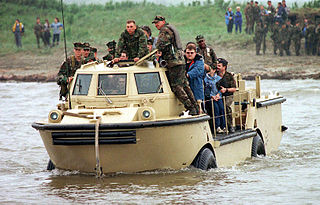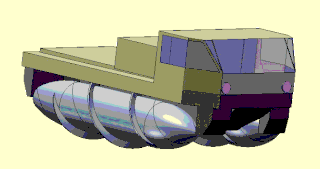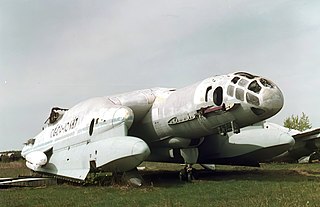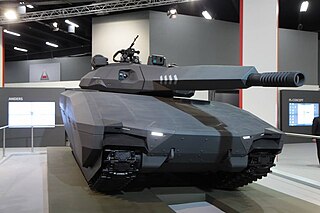
The ZIL-2906 or ZIL-29061 is a screw-driven amphibious craft from the Russian ZiL vehicle manufacturer. [1]

The ZIL-2906 or ZIL-29061 is a screw-driven amphibious craft from the Russian ZiL vehicle manufacturer. [1]

The vehicle was designed to recover re-entered Soyuz space capsules from difficult terrain. It was carried on the back of a ZIL-4906 (which had a top speed of 80 kilometres per hour (50 mph)) until it reached terrain impassable for the latter. At this point the ZIL-2906 would be unloaded and resume the search. [2]

An amphibious vehicle, is a vehicle that is a means of transport, viable on land as well as on water. Amphibious vehicles include amphibious bicycles, ATVs, cars, buses, trucks, combat vehicles, boats and hovercraft.

Transrapid is a German-developed high-speed monorail train using magnetic levitation. Planning for the Transrapid system started in 1969 with a test facility for the system in Emsland, Germany completed in 1987. In 1991 technical readiness for application was approved by the Deutsche Bundesbahn in cooperation with renowned universities.

The BMP-1 is a Soviet amphibious tracked infantry fighting vehicle. BMP stands for Boyevaya Mashina Pekhoty 1, meaning "infantry fighting vehicle, 1st serial model". The BMP-1 was the first mass-produced infantry fighting vehicle (IFV) of the Soviet Union. It was called the M-1967, BMP and BMP-76PB by NATO before its correct designation was known.

The Beriev Be-103 is an amphibious seaplane designed by the Beriev and constructed by the Komsomolsk-on-Amur Aircraft Production Association (KnAAPO) in Russia. Intended for autonomous operation in the unmarked areas of Russia's far north and Siberia, the Be-103 was designed for short-haul routes in regions that have rivers, lakes and streams, but are otherwise inaccessible.

A screw-propelled vehicle is a land or amphibious vehicle designed to cope with difficult snow and ice or mud and swamp. Such vehicles are distinguished by being moved by the rotation of one or more auger-like cylinders fitted with a helical flange that engages with the medium through or over which the vehicle is moving. Modern vehicles called Amphirols and other similar vehicles have specialised uses.

The Bartini Beriev VVA-14Vertikaľno-Vzletayushchaya Amfibiya was a wing-in-ground-effect aircraft developed in the Soviet Union during the early 1970s. Designed to be able to take off from the water and fly at high speed over long distances, it was to make true flights at high altitude, but also have the capability of flying efficiently just above the sea surface, using aerodynamic ground effect. The VVA-14 was designed by Italian-born designer Robert Bartini in answer to a perceived requirement to destroy United States Navy Polaris missile submarines. The final aircraft was retired in 1987.

The Caparo T1 is a British mid-engine, rear-wheel drive, two-seat automobile built by Caparo Vehicle Technologies, founded by design director Ben Scott-Geddes, engineering director Graham Halstead, engineers formerly involved in the development of the McLaren F1 and Sean Butcher, marketing director and financier. The T1 was inspired by Formula One design, and intended as a relatively affordable road legal racing car. The T1 was scheduled for production in mid-2007 for a price of GB£235,000 with approximately 25 cars per year built.

The ZIS-151 was a general-purpose truck produced by the Soviet car manufacturer Automotive Factory No. 2 Zavod imeni Stalina in 1947–1958. In 1956, the factory was renamed to Zavod imeni Likhacheva, and new trucks were called ZIL-151 (ЗИЛ-151).

The ZIL-135 is a large, eight-wheeled military transport and self-propelled artillery truck produced in the Cold War by the Soviet Union starting in 1959. Its purpose was to carry and launch an artillery missile, specifically a FROG-7, from surface-to-surface. The ZIL-135 was widely exported to other communist countries, most notably North Korea, where it is a common sight in films and military marches. It also served as the TEL for the BM-27 Uragan artillery rocket system.
Launch commit criteria are the criteria which must be met in order for the countdown and launch of a space shuttle or other launch vehicle to continue. These criteria relate to safety issues and the general success of the launch, as opposed to supplemental data.

The ZIS-485, army designation BAV, is a Soviet amphibious transport, patterned after the WWII American DUKW.

The R-17 Elbrus, GRAU index 9K72 is a tactical ballistic missile, initially developed by the Soviet Union. It is also known by its NATO reporting name SS-1C Scud-B. It is one of several Soviet missiles to carry the reporting name Scud; the most prolifically launched of the series, with a production run estimated at 7,000 (1960–1987). Also designated R-300 during the 1970s, the R-17 was derived from the R-11 Zemlya. It has been operated by 32 countries and manufactured in four countries outside the Soviet Union. It is still in service with some. It's been called the Hwasong-5 in North Korea.

The RG Outrider, also known by its original designation RG-32M Light Tactical Vehicle (LTV), is a 4x4 multi-purpose mine-protected armoured personnel carrier (APC) manufactured by BAE Systems of South Africa. It was first introduced in early 2009 as the RG-32M LTV, and was first purchased by Ireland. The vehicle was offered to the US market the following year, re-designated as RG Outrider. It is based on and is the successor to the RG-32M already in service in Afghanistan with the coalition forces. The RG Outrider offers several improvements over its predecessor, including the addition of the V-shaped hull.

The Pinzgauer is a family of high-mobility all-terrain 4WD (4×4) and 6WD (6×6) military utility vehicles. They were most recently manufactured at Guildford in Surrey, England by BAE Systems Land & Armaments. The vehicle was originally developed in the late 1960s and manufactured by Steyr-Daimler-Puch of Graz, Austria, and was named after the Pinzgauer, an Austrian breed of horse. It was popular amongst military buyers, and continued in production throughout the rest of the century. In 2000 the rights were sold to Automotive Technik Ltd (ATL) in the UK. ATL was subsequently acquired by Stewart & Stevenson Services, Inc. in 2005; in May 2006, Stewart & Stevenson became a subsidiary of the aerospace and defence group Armor Holdings, Inc.. One year later, Armor Holdings was acquired by BAE Systems plc, who discontinued UK production of the Pinzgauer, which was proving to be vulnerable to mines and improvised explosive devices in Afghanistan. Development work on a planned Pinzgauer II was evaluated by a BAE subsidiary in Benoni, Gauteng, South Africa but no vehicle was ever made.
The Heilmann locomotives were a series of three experimental steam-electric locomotives produced in the 1890s for the French Chemins de Fer de l'Ouest. A prototype was built in 1894 and two larger locomotives were built in 1897. These locomotives used electric transmission, much like later-popular diesel-electric locomotives and various other self powered locomotives.

Bryansk Automobile Plant is a Russian manufacturer of military vehicles based in Bryansk, Russia.

PL-01 was a Polish light tank mockup created by OBRUM with support from BAE Systems, based on the Swedish CV90120-T light tank. The concept vehicle was first unveiled at the International Defence Industry Exhibition in Kielce on 2 September 2013.

Kamaz Typhoon is a family of Russian multi-functional, modular, armoured MRAP vehicles manufactured by the Russian truck builder Kamaz. The Typhoon family is part of Russia's Typhoon program. As of early 2021, the number of Typhoons in the Russian Armed Forces fleet is more than 315 units of Typhoon-K.

The ZIL-4112 is a luxury car with a limousine body type built by ZIL of Russia.
| Wikimedia Commons has media related to ZIL-29061 . |